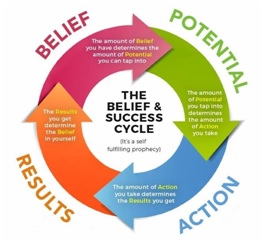A Coaching Power Tool By Maryan Cabdi, Parents Coach, UNITED KINGDOM

What Does It Mean to Challenge Your Perception vs. Accept Your Perception
The only thing that’s keeping you from getting what you want is the story you keep telling yourself’–Tony Robbins
It is human nature to hold beliefs, thoughts, and ideas and then use them as a filter to make sense of the world around us and build perspectives. Beliefs can be divided into two categories: empowering or disempowering perspectives. Positive beliefs help us to grow and achieve our goals, whereas negative beliefs hold us back from reaching our full potential.
Challenge Your Perception vs. Accept Your Perception Definition and Meaning
What Does It Mean “TO CHALLENGE” Our Perception?
Our beliefs are powerful because they color the lens through which we view the world. Our beliefs define who we are and how we conduct ourselves. Most of the beliefs we tend to hold originated from childhood experiences, things parents used to say to them, or the surrounding environment and events. People can easily believe what they hear and keep hearing from others, and the danger is when those beliefs are disempowering, they can keep them trapped with negative ideas and infested in fear, pain, and lost opportunities.
So challenging perceptions means taking ownership of our stories and challenging what is written by others, it means focusing on everything disempowering in our lives such as what beliefs, think, or know in our world that is holding us back from any progress. As Marion Franklin said in her book Laser Coaching
We form assumptions everyday based on how we perceive things, Problems occur when you accept untested assumptions as truth.
What Does ‘Accepting Perception’ Mean?
Unconsciously disempowering thoughts can sabotage our abilities by taking halfhearted actions and that leads to ineffective results. As Tony ROBBINS says in his book ‘What do you Believe’ the following
Little action equals lousy results. Lousy results equal uncertainty and disheartened beliefs. It is a vicious cycle that only ends when you decide to change what you’re putting into it.
Challenge is an empowering perspective :
A vital role of the coach is to evoke awareness of the client about any negative perception that is not serving the client and use powerful questions so the client can choose whether to challenge the unhelpful perception they hold or accept it is true.
So this power tool can be used as a first step for any transformational change, it helps us to spot any negative thoughts that are blocking us from progressing in our lives and address whether we are going to challenge this limiting belief or just accept and helplessly sit with it and allow it to sabotage our success in any situation.
A Case Study
Consider the story of Layla. She was born to a distant and detached mother who kept telling her she is worthless and not smart like her siblings, and can not talk properly in front of relatives and family friends. These engrained childhood beliefs have led Layla to develop poor self-worth and accepted these negative perceptions as her ultimate truth. In her adulthood, she considered herself a boring conversationalist with others. She believed she was not smart enough to apply for her favorite jobs. Later on, when Layla was in her thirties she encountered a transformational coaching experience, Layla was able to identify and challenge her perceptions such as I am not smart, I am not good at communicating with others, I am not loved. Layla also identified her strengths and talents. Using the power tool Challenge vs Accept she was able to reframe those negative beliefs about herself into positive ones. Through continuous coaching, Layla worked hard on how to regain confidence in building meaningful relationships and appreciate her self-worth.
Coaching can support clients to become aware of how they unconsciously accepted negative thoughts or ideas and turned them into their current paradigm.
‘Challenge your perception vs. Accept your perception’ power tool can be used when the client’s beliefs need to be examined and challenged instead of holding those beliefs/assumptions as the ultimate truth.
How I Use This Challenge Your Perception vs. Accept Your Perception Power Tool in My Personal Life:
I have lots of work and personal life commitments being a full-time employee, an entrepreneur mother, wife, and daughter to an elderly parent, although I really enjoy my different responsibilities I face time to time mental and physical pressure and this is where the negative train of thoughts bob up, So if I notice a repetitive disempowering thought, I make time for self-reflection exercise I apply these five steps as follows-
1 . I catch the negative idea by saying it out loud. For example ‘’ I don’t have time for my self-care’’.
2 . I examine the truth in this thought and where this belief is coming from.
3 . I ask myself challenging questions as the following:
- Is it really true that I don’t have time for my self-care activities?
- What is stopping me from making time?
- What is going to happen if I don’t make time for my self-care?
4 . I change the negative thought into empowering one ( positive affirmation) Like ‘’ I have 24 hours I can certainly have 20 minutes for my workout’’. MY SELF-CARE is important and I make time for important things in my life.
5 . Plan for a simple action in alignment with my new empowering idea, I do this by using the SMART goal-setting model.
‘Challenge Your Perception vs. Accept Your Perception’ Is a Coaching Power Tool That Assists the Client in First Testing Their Perception to Determine Whether It Is True or a Limiting Belief.
As a parenting program trainer and parenting Coach, I hear so many parents with a disempowering beliefs like I can not change my relationship with my son he is so difficult, I can not stop being angry every time the children make mistakes I can be consistent with family rules and routines, it is hard for me to praise my child because I am not used to it.
So when I hear these limiting beliefs, in a non-judgmental and safe coaching conversation I invite my clients to pay a closer look at their beliefs and examine what’s true about this following this process:
- Identify one of your limiting beliefs.
- Recognize that it is just a belief and beliefs can change . …
- Ask questions to test and challenge this disempowering belief. Like for example
- Recognize the potentially damaging consequences of holding to these beliefs.
- Take responsibility to create and adopt a new belief. …
- Put it into practice.
Combining Different Coaching Tools With Challenge Your Perception vs. Accept Your Perception
In the coaching conversation, the client’s limiting beliefs show up as the way a client thinks about themselves, or the world around them. So This power tool can be beneficial in identifying the negative thoughts that stop the client from facing a challenge or pursuing a desire. However this power tool is not enough to create a transformational change, it has to be combined with other coaching tools such as SMART goal setting to support the client to take important actions in their life.

The Tony Robbins success Cycle is an example of combining different coaching tools. The empowering belief leads to greater potentials revealed, the great potential leads to a positive attitude and the desire to shape great actions, then SMART actions lead eventually to positive results, then great results lead to more confidence and self-belief and ‘I can do this’ Attitude and continuous like that with progress.
In summary, ‘Challenge vs. Accepting’ is a coaching power tool that helps the client first to test their perception if it is true or a limiting belief. The coach can use this tool to help the client to challenge any disempowering or negative previous beliefs instead of just accepting them. Secondly, after awareness is evoked about the disempowering beliefs it inspires the client to reframe it with more empowering new beliefs and use daily positive affirmations to root down this new belief till it becomes reality.
References
Franklin, M(2019)The Heart of Laser Focused Coaching, Published by Thomas Noble Books, Wilmington, DE, USA.
T.S. Sathyanarayana Rao, M. R. Asha, K. S. Jagannatha Rao, P. Vasudevaraju
Indian J Psychiatry. (2009) The biochemistry of belief, Research Institute, Mysore, India.
Tony Robbins Success Cycle (2017) Added by Harry AinslieRobbins
What Do You Believe, E.book, Research International, Inc Available At: www.tonyrobbins.com [accessed 5 Nov22]